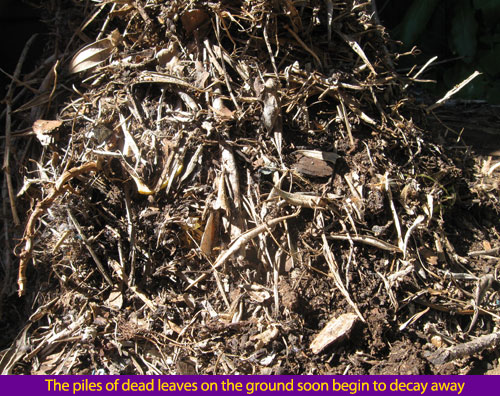

Unlike a typical compost pile that you create and continue adding to as materials become available, a leaf pile can be made up all at once.

#Do leaves decompose on their own how to#
Product Link: WORX Electric Leaf Shredder Building Your Pile For Success – How To Compost Leaves Fast The electric models are surprisingly sturdy and efficient, and can be found at a far lower cost than gas models. There are also a wide range of electric and gas leaf shredders now on the market that do an excellent job of shredding leaves. It’s easy to do, and makes quick work of the task. We use our push mower and bag attachment to shred huge piles of leaves quickly every fall.

It is a simple formula: the smaller the leaves are shredded, the faster they will decompose.Ī push mower or riding mower can quickly accomplish this task with ease. But by shredding the leaves, you create hundreds of smaller edges that can break down fast. And that is exactly why shredding your leaves before building your compost pile is critical!Ī whole leaf has one edge line around its entire perimeter. Not only do they mat down and become soggy, whole leaves also prevent airflow and oxygen, which is a vital ingredient in heating up a compost pile. Whole leaves can take years to fully break down. But by shredding them first, you can break them down in mere months. When left whole, leaves can take two to three years to break down. And to do that, it all starts with shredding. So now that you know the best leaves to use, it’s all about building a leaf-filled compost pile that will decompose as fast as possible. Shred Those Leaves – The Key To Fast Compost! It’s simply best to leave them out of the pile to be safe. Although the toxin is concentrated in the nuts of these trees, it can be hard to separate out when collecting. They can also prevent some seed crops from germinating.Īs for the horse chestnut and its close relative the Buckeye tree, they can produce a toxin that can be harmful to humans and animals if in high enough doses. The leaves from walnut and eucalyptus contain toxins that can harm plants.

Walnut, eucalyptus and horse chestnut (buckeye) leaves should be completely left out of a pile. There are a few tree’s leaves to avoid all together when it comes to composting. Tree Leaves To Avoid Composting – How To Compost Leaves Fast At this ratio, the PH of your compost will still be perfect for using for vegetables and flowers. This doesn’t mean you can’t use oak leaves in your pile, but it is best to keep the ratio of oak leaves to others at 20 percent or below. In addition, oak leaves are among the lowest in nitrogen and other trace nutrients, so they simply do not provide as much energy to the finished compost. You can use oak leaves in moderation, but since they lean toward the acidic side, they can throw a pile’s PH level off.
#Do leaves decompose on their own full#
They are abundant, break down quickly, and are full of nutrients as well. Maple leaves are the star of the show when it comes to the best leaves to compost. At the top of that list are the leaves of oak trees. But there are other leaf varieties you will want to limit in your pile’s makeup. When it comes to the leaves listed above, the more the better. Not only do these leaves contain the best nutrients, their leaf structure also happens to break down quickly. All of these are excellent choices to create great compost. As you will see below, some tree’s leaves are not well-suited for compost, while others need to be used in moderation.Īt the top of the list of “great leaves” are maple, birch, ash, cherry, cottonwood and fruit trees. When it comes to making great compost from leaves, it all starts with selecting the best varieties of leaves. With that in mind, here is a look at how to turn an overabundance of leaves into the best soil amendment ever – amazing, all-natural compost! How To Make Incredible Compost From Leaves Select The Best Leaves For Composting Even better, you can do it faster than ever by following a few tried and true methods that will have your pile cooking down quickly. And there is no better way to make loads of it than by using Autumn’s treasure trove of leaves as a base.īut luckily, by utilizing Autumn’s sensational bounty of falling leaves now, you can make more than enough compost for all of your plants next spring and summer. Nothing can help build and power soil and plants better than compost.


 0 kommentar(er)
0 kommentar(er)
